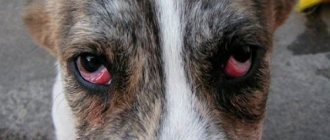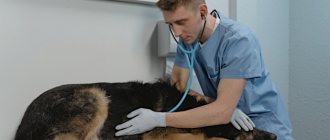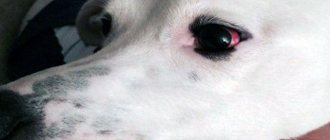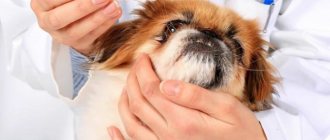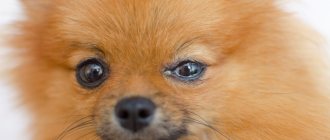The eyes are the mirror of the soul; they reflect the dog’s mood and state of health. If the dog is healthy, nothing bothers her, there is a healthy shine in her eyes, and there are no foreign secretions.
When a pet is unwell, purulent discharge may appear, which signals that the animal needs careful examination and treatment. Today we will examine in detail the topic of why a dog’s eyes fester, how to treat it, and whether it is possible to remove purulent discharge from a dog’s eyes at home.
What to do if your dog's eye is infected
A responsible and attentive owner will certainly notice the slightest deviations in the health of the pet. If you find pus in your dog's eyes, treatment should be prescribed by a veterinarian; self-medication in these cases can only worsen the situation. Advice from the Internet will not help either, remember that each case is purely individual, you cannot be completely sure that your situation is 100% identical to the described case and the used eye drops for dogs from pus will help.
The first thing you need to do is make an appointment with a veterinarian or call your doctor at home. We do not recommend delaying seeking medical help; this is fraught with deterioration of vision, further development of the inflammatory process and even death if the cause of the discharge lies in serious diseases. Only a doctor can find out the true causes of the disease, carry out diagnostic measures and prescribe the only possible treatment.
Memo to the owner
- The first step is to clear the eye of any discharge. This will allow for an examination and will also bring some relief to the pet’s condition. You need to remove the pus with a clean bandage; cotton wool is worse in this regard, as it can stick to the sore eye. The bandage needs to be moistened, for which a decoction of chamomile, calendula or other anti-inflammatory herbs is suitable. In fact, this is where first aid ends. But when a veterinarian is unavailable, what should you do? The dog’s eye is red and purulent, which means there is an inflammatory process. To level it out, it is necessary to use antibiotics.
- The selection at the pharmacy is quite extensive. Most often, pharmacists offer Albucid. But this drug causes a strong burning sensation, so it is better to look for an alternative. Levomycetin helps great when the eyes are red and festering. Eye drops do not cause discomfort to dogs; they can be instilled up to 6 times a day. And of course, before each procedure you need to remove pus from the eyes.
- Ciprovet drops are good for relieving inflammation. They are instilled 1-2 into each eye, four times a day.
- You can wash your eyes with furatsilin solution. To do this, you need to dissolve one tablet in a glass of warm water. You can combine this treatment with anti-inflammatory drops.
- Tetracycline ointment helps a lot. It should be applied under the animal’s drawn eyelid. After this, close your eye and massage it well.
When is veterinary care required?
If you know with certainty the reason why your dog’s eyes are watering, it does not threaten his life, you can postpone your visit to the doctor. In such cases, you can get by with home care, rinsing with a neutral saline solution until the symptoms disappear.
But there are symptoms that cannot be ignored:
- severe redness of the eyeball;
- irritation that prevents the dog from fully opening the eyelid or blinking;
- severe itching as a result of fairly accumulated pus;
- severe swelling;
- the presence of blood in the tear secretion;
- unpleasant smell of purulent discharge.
In these cases, only an experienced veterinarian can find out what is causing the dog’s eyes to fester and what treatment your pet will need. Let's look at the main causes of purulent discharge.
Weakening of the immune system
Just like humans, our little brothers have many diseases. This refers to ailments not only of the visual organs, but also of the heart, lungs and liver. Any of them provokes a weakening of the immune system, which also contributes to the penetration and development of eye infections. Therefore, it is so important to first diagnose and only then begin treatment.
The dog's eyes are red and fester very often in old age. This is due to a natural decrease in immunity. Therefore, in animals over 10 years of age, this problem is considered a normal variant. The doctor can select chloramphenicol, tetracycline or other drops that will help maintain eye hygiene.
Irritation as a result of external influence
Green discharge from the eyes of a dog can be a reaction of the delicate mucous membrane to exposure to allergens, trauma to the eyeball, or the ingress of a small foreign object that interferes with normal tear production.
What can damage the eye shell:
- smoke;
- dust;
- hair;
- sand, etc.
The moist environment formed as a result of constantly flowing tears acts as a beneficial environment for the development of pathogenic microorganisms, causing bacterial complications that can be eliminated by antibiotic therapy.
What you need
For rinsing, you will need cotton pads (gauze pads), one of the solutions, and medications (if the pet is prescribed a course of therapy). The treatment process itself does not cause pain or other unpleasant sensations in the dog. Therefore, most people tolerate this procedure calmly. Problems may arise when taking eye drops, as some may sting.
How often do you need to care for your dog’s ears, and what lotions, drops and other products are used at home?
Conjunctivitis in a dog
If your dog's eyes are watery and purulent, you need to rule out inflammation of the conjunctiva. This is a rather dangerous inflammatory disease, which is provoked by a bacterial infection.
Symptoms of a serious condition:
- The dog’s eyes become very festered, the animal has difficulty moving its eyelids;
- the discharge takes on a dark shade - green or brown;
- the eyelids are often stuck together with a crust.
In such cases, only the veterinarian prescribes what to wash the dog’s eyes from pus and directs further therapy, adjusting it depending on the progress.
Response to Trauma
If the dog lives in an apartment and walks under the supervision of the owner, then there is not much chance that he will not know about the event that occurred. It’s another matter if the animal goes outside on its own. If the next day after the dog returns one eye is red and festering, it can be assumed that it was damaged during a skirmish with tailed rivals or cats. If an animal has damaged its eye, the discharge will be clear at first, and only after infection has attached does pus appear.
It can be even simpler. The dog was injured after running into a branch. Or a small pebble bounced off and hit your eye. In this case, exactly the same thing happens as in people after a blow. The dog's eye is red and festering, he is worried or tries to spend more time in his house.
In case of eye injuries, it is indicative that problems are observed only on one side. The dog squints the injured eye or closes it completely. The second one is clean. Treatment in this case is symptomatic. It is necessary to examine the eye to ensure that there are no foreign objects left in it. After this, treat with chamomile or calendula infusion and observe. If the condition does not improve within two days, contact your veterinarian.
Eyeball injury
Given the curiosity and high mobility of four-legged pets, they can easily injure themselves unintentionally.
Eyeballs can be damaged as a result of:
- hit by a foreign object;
- scratching the mucous membrane with claws while scratching;
- the animal may get hurt during a fight.
The veterinarian must examine the animal, remove the foreign body that has entered the eyelid, and prescribe therapy aimed at combating the consequences. It must be said that assessing the severity of a mechanical injury can be quite difficult; signs of pathology may appear after some time. If both eyes of the dog become infected, there is a high probability of a serious head injury, then the treatment becomes more in-depth.
How can you accurately determine the cause of the pathology?
The exact cause of red eyes can only be determined after a comprehensive examination at a veterinary institution. The doctor will examine the pet and conduct tests that are necessary in a particular situation (blood, cytology).
If there is pus discharge from the eyes, a viral infection is a possible cause. In this case, swabs are taken. The received materials are sent to the laboratory for further research using PCR and ELISA methods.
Allergy
If your dog has allergies, increased tearing may be a result of interaction with the allergen. In parallel with irritation of the mucous membrane, itching, hair loss, and swelling may appear.
What could be an allergen:
- plant pollen;
- certain foods;
- antiparasitic drugs;
- household chemicals;
- cosmetics, etc.
Do not rush to put drops into the eyes of dogs for pus, it may be due to a change in diet. If this is confirmed, the symptoms will go away after changing the food to hypoallergenic.
Do not try to play the role of a doctor and treat an animal.
Medicines are sold in pharmacies in the form of lotions, drops and ready-made solutions. You can also purchase sanitary napkins for your eyelids. The drugs have different prices and purposes. The listed remedies should be used with caution.
If rinsing does not help, the dog must be taken to the veterinarian. Before purchasing a medicine, you need to carefully study its composition. You should not take solutions that contain antibiotics, hydrogen peroxide, ethyl alcohol and other aggressive chemical components.
Helminth infection
Perhaps you forgot to carry out deworming in time and the answer to the question why the puppy’s eyes fester is infection with worms.
If this is so, then in addition to inflammation of the mucous membrane, the animal will suffer from other manifestations of the disease:
- intoxication;
- elevated temperature (not always);
- itching in the anus.
Treatment in this case should be primarily aimed at combating worms. At the same time, the doctor prescribes local medications to normalize tear production and eliminate signs of infection.
Lack of vitamins
This is also directly related to nutrition. Purulent lacrimation may be caused by a lack of vitamin A. It is found in offal, vegetables, herbs and eggs. Most often, animals that do not have the opportunity to eat properly and variedly suffer from hypovitaminosis. This should also include those who eat plenty, but their diet is limited by low-quality economy-class food, poor in vitamins and microelements. In this case, the only thing that needs to be done is to diversify the diet with meat, fish, grains and vegetables. Gradually the condition will return to normal.
Pathologies of the eyelids and eyeball
The cause of a serious inflammatory process may be congenital ophthalmological pathologies:
- abnormal growth of the eyelash row;
- non-standard arrangement of eyelashes;
- entropion and ectropion of the century;
- impaired patency of the lacrimal canal;
- pathology of the structure of the eyelid, cornea.
Due to the fact that the outflow of tear fluid is disrupted, a favorable environment for the proliferation of microbes is formed, chronic conjunctivitis can develop, which is especially typical for breeds such as pugs, Shih Tzus and others with bulging eyes.
Associated symptoms
If there is a small amount of clear discharge, you don’t have to worry about your pet’s health. The reason for their appearance is accumulated tear fluid. The presence of pathology is indicated only when the color of the discharge changes to yellow-green, grayish or red.
In addition to the color change, you should pay attention to other accompanying symptoms. Depending on the cause, abnormalities can occur not only in the eyes, but also in other organs.
Tumor of the eyelids
Due to constant itching, the animal scratches its eyelids with its paws or by rubbing against surrounding objects. Scratching causes irritation and injury, accompanied by swelling of the eyelids.
Redness
If the proteins are clean, then one or more hemorrhages, characteristic of mechanical damage, can be seen in them. If the irritation is too strong, the entire protein turns red. Redness is accompanied by a burning sensation and profuse lacrimation.
Itching
Untreated wet areas dry out on their own and form crusts. They are accompanied by itching and pain, so the animal constantly tries to relieve the discomfort with the help of its paws.
Deviations not related to the eyes
Deterioration of the condition can be noticed by behavioral changes. A sick pet loses its usual activity, does not follow commands well, avoids communication and refuses its favorite treats. Also, the presence of the disease can be indicated by the appearance of vomiting, fever, unpleasant odor from the ears, bloating, diarrhea or constipation.
Infectious diseases
Eye drops for dogs for purulent discharge are prescribed if the dog is diagnosed with otitis media. This may be indicated by frequent shaking of the head and scratching of the ear on the affected side.
Bacterial and viral infections can also cause eye disease. Most often, old animals, puppies with a weak immune system, and dogs with chronic diseases are susceptible to infection. Common diseases that often cause complications in the eyes are plague, mycoplasmosis, enteritis, hepatitis and others.
Irritation of the mucous membranes of the eyes
We continue to consider possible reasons. Are your dog's eyes red and puffy? Maybe she has recently had the opportunity to come into contact with caustic substances such as bleach, turpentine, alcohol? If the animal has access to the garage, then this is quite possible. It should be added here that one-time inhalation of vapors leads to lacrimation. But if the dog is forced to inhale fumes of caustic substances regularly, the discharge may become purulent. In this case, it is necessary to exclude contact, after which improvement will follow. In addition, the doctor may recommend washing the eyes with light antiseptics and herbal decoctions.
How to properly treat your eyes
To wash the eyes, use a saline solution, an infusion of herbs cleared from tea leaves, or a weak solution of furatsilin. To avoid damaging the delicate mucous membrane, make sure that the liquid is not too hot.
You will need:
- cotton pads;
- paper napkins;
- prescribed medication.
Moisten a cotton pad, carefully moving from the outer to the inner corner of the eye, remove the accumulated pus, use a new pad for each eye. Dry the treated area with a napkin, drop in the required amount of medicine, and gently massage your eyelids so that the medicine is distributed evenly. To prevent your pet from scratching its eyes, you can wear a protective cone collar.
How can you wash your dog's eyes at home?
Regular eye hygiene products can be used as needed. It is not recommended to use drugs with therapeutic effects independently without diagnosis and consultation with a doctor.
Important requirements for the rinsing solutions used:
- Before use, hold the liquid in your palm for some time to warm it up.
- Follow the rules of asepsis.
- Follow all recommendations of the veterinarian-ophthalmologist for performing procedures (sequence, frequency, intervals between manipulations, etc.).
Pharmacy products
- 0.9% sodium chloride solution. The most affordable means for carrying out the procedure. Saline solution is used for copious rinsing and removal of contaminants.
- Furacilin. To obtain a concentration that can be used for the procedure, you need to dissolve 1 tablet (20 mg) in 100 ml of sterile distilled water. The solution is used to wash the eyes of a dog with inflammation of various etiologies.
- You can wash your dog's eyes with a solution of Chlorhexidine, diluting it to a concentration of 0.01%. To do this, take 4 ml of the drug and add 16 ml of sterile saline solution.
- Miramistin can be used to wash your pet's eyes in the original concentration. It is used for dogs as part of complex therapy for various pathologies.
Expert opinion
Kuzmenko Olga Olegovna
Information about the expert
Ask a Question
Be sure to follow the instructions for storing the drug: temperature, presence of light, permissible duration of use after opening the bottle. Expired drops should never be used.
Special cleaning products
- Diamond eyes. Drops are used for preventive and therapeutic purposes for conjunctivitis and various infections of the organ of vision.
- Espree lotion is a veterinary hygiene product.
- Ophto-Lavas solution is intended for hygienic purposes and has a soothing effect.
- Oftal (from Beaphar) is suitable for daily treatment and rinsing.
Folk remedies
- A decoction of chamomile flowers. To avoid getting plant particles into the prepared solution, it is better to buy the drug in special tea bags. 1 filter bag is immersed in hot water (200 ml) and left to infuse for 15 minutes. Cool the prepared broth before use. You can rinse with chamomile for various pathologies, as well as for the purpose of daily hygienic cleaning.
- Tea brewing is the most popular folk remedy that can be used to wash out a festering eye, as well as remove normal mucous discharge. Treatment with tea is carried out several hours after it is brewed.
Prevention
In order not to encounter serious problems with the dog’s health in the future, owners need to notice the slightest manifestations of symptoms and follow generally accepted rules for the prevention of ophthalmological diseases:
- bring animals for vaccination on time;
- Give your dog antihelminthic medications regularly according to the schedule;
- Make sure your dog is properly fed: for puppies, choose food enriched with vitamin A; for dogs with allergies, it is better to choose a hypoallergenic diet;
- Carry out eyelid hygiene daily, remove dirt and dried crusts;
- if you have a dog with a naturally convex eye shape, instill special drops daily;
- remove overgrown hair around the eyelids by trimming;
- maintain hygiene;
- walk in safe places where the dog will not get hurt;
- Consult a doctor at the first signs of an onset of illness.
Simple rules will help maintain the health of your beloved dog and protect you from serious problems. Be attentive to your pet, and he will certainly repay you with sincere love and devotion.
Algorithm for the procedure
- Prepare all the necessary tools in advance (cotton pads, a syringe without a needle, rinsing solutions should be at a comfortable temperature).
- Hands are washed thoroughly and, if necessary, disposable medical gloves are worn.
- The pet is called to you and seated (representatives of small breeds can be placed on the table).
- Use your left hand to fix the animal's muzzle so that it does not twitch. With the other hand, wipe the eye with cotton wool soaked in the prepared solution. The movement is carried out from the outer corner to the inner (towards the nose).
- If it was not possible to remove all the dirt at one time, repeat the steps using a new piece of cotton wool.
- If there are purulent crusts on the eyelashes and eyelids, they should first be softened by applying a cotton pad for a few seconds, or by dropping a hygiene product directly onto the problem area.
- The second eye is treated in the same way.
- If it is necessary to wash a wound on the eye, the animal’s eyelids are carefully closed with two fingers and sanitation is carried out. For this procedure, you can use a solution of Chlorhexidine or Miramistin.
After the procedure is completed, the pet is praised and rewarded with a treat or play.
Diagnostic methods
The veterinarian collects a detailed medical history. The owner should talk about the behavior and well-being of the pet recently, remember what preceded the pathology: stress, excitement, fight, illness.
Tell your veterinarian if you observe:
- itching (the dog rubs its eyes with its paw);
- corneal clouding (frequent blinking);
- inflammation, swelling in the eye area;
- discharge from the lacrimal duct, the presence of pus in it;
- increased lacrimation;
- asymmetry of the pupils;
- nature of the pathology (vascular network, redness of the eyelids, ulcerative lesions).
Pay attention to the general condition of the dog: body temperature, activity, appetite.
During diagnosis, a veterinarian-ophthalmologist examines the dog, assessing the condition of its eyelids and eyeballs. If glaucoma is suspected, tonometry is performed, measuring eye pressure.
The Schirmer test helps to exclude dry keratoconjunctivitis. It is designed to determine the amount of tear fluid secreted. The presence of microtraumas is also checked using a special fluorescent lamp.
To identify or exclude infectious pathologies or hormonal imbalances, a general blood test is performed. If necessary, an ultrasound examination is prescribed, which allows you to determine the presence of organic changes and complications of the disease (clouding of the lens).
If retinal detachment is suspected, an examination of the fundus and the condition of the optic nerve is performed - ophthalmoscopy.
